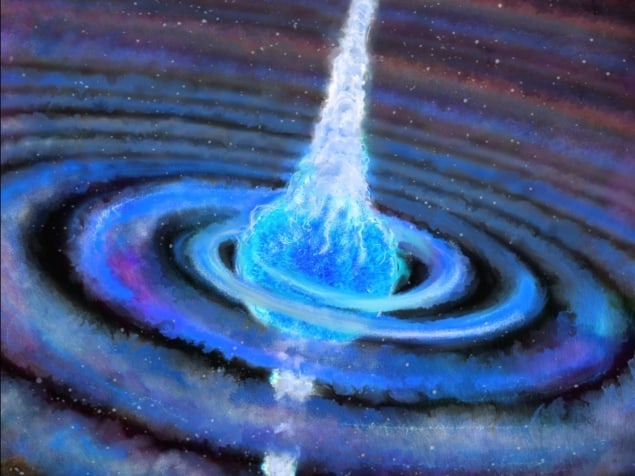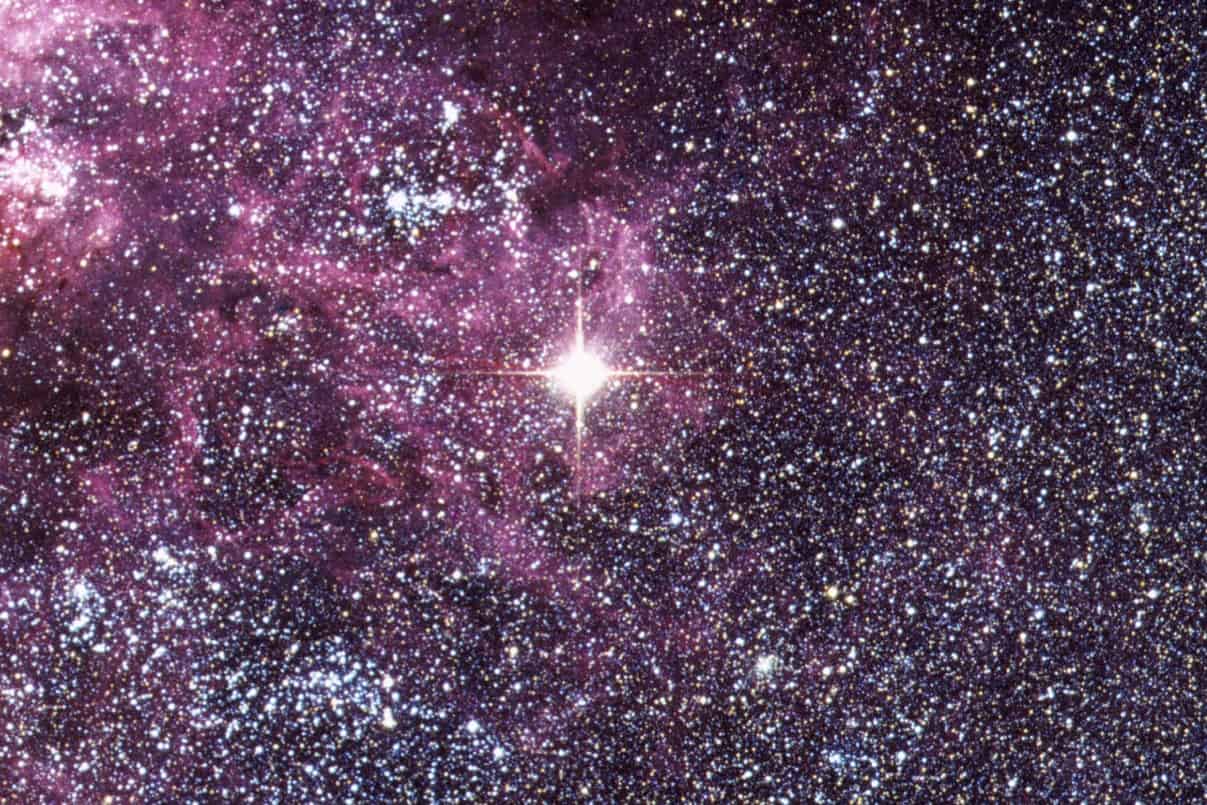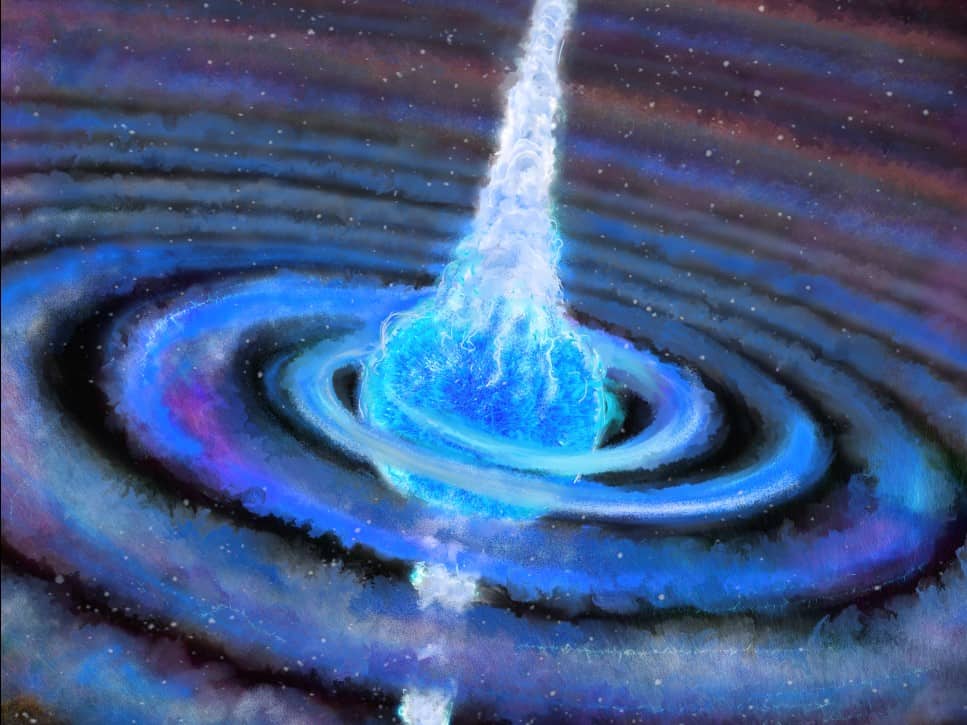
A black hole or a neutron star may have merged with a normal massive star and caused it to explode in a supernova, according to Caltech’s Dillon Dong and colleagues. Dong says that such explosions could occur at minimum rate of “one explosion per 10 million years in a galaxy like the Milky Way”.
Many stars are born in pairs, and two stars massive enough to explode as supernovae can be close companions. In such binary systems, the more massive of the two stars will explode first and in most cases a compact object – a neutron star or a black hole – will be left behind.
Astronomers have speculated that if the compact object is close to its surviving companion star, it can spiral into the star’s atmosphere, eventually sinking to the companion’s core where it disrupts the star, causing it to go supernova prematurely. Now, Dong’s team says that it has discovered evidence for such an event in a search of archive data from the Very Large Array Sky Survey (VSS), covering the period between September 2017 and February 2018.
Anomalous sources
The team looked for anomalous but luminous radio sources. They then compared their candidate sources to equivalent observations of the same part of the sky from the Faint Images of the Radio Sky at Twenty Centimetres (FIRST) survey, which was also conducted by the Very Large Array between 1994 and 2005.
One radio source in particular, catalogued as VT 1210+4956, stood out as not being present in the FIRST data. This means that it appeared sometime between 2005 and 2017. Further investigation found that it is situated in a dwarf galaxy about 500 million light–years away.
Following up with the Low Resolution Imaging Spectrometer on the Keck I telescope on Mauna Kea, Hawaii, Dong’s team identified a massive outflow of ionized gas from the source. The Monitor of All Sky X-ray Image (MAXI) experiment on the International Space Station had also detected a soft X-ray burst from the same location on 14 August 2014.
Compact object
With all these observations to hand, Dong’s team were able to piece together what happened. They suggest that long ago, a massive star in a binary system exploded, leaving behind a compact object. When the other star in the system started nearing the latter stages of its life, it ran out of hydrogen in its core and turned to fusing helium instead. This raised the temperature of the star so hydrogen fusion could occur in the star’s envelope, prompting the star to expand. Gradually, the compact object came to be within the star’s atmosphere.
The gravitational tidal interaction between the compact object and the star’s atmosphere saw the star begin to eject huge amounts of material at a rate of 0.04 solar masses per year. This process is estimated to have begun only about 400 years ago, whereas other stars that experience mass loss before going supernova do so for tens of thousands of years before exploding.
This outflow of material formed a dense torus of circumstellar material around the star, which is what Keck observed. Then, in 2014, the compact object reached the star’s core and started ripping it apart from the inside out. An accretion disc of matter around the compact object formed inside the star, and the compact object’s powerful magnetic fields whipped up some of this matter and blasted it away in relativistic jets that emitted the X-ray burst detected by MAXI, and which prompted the star to explode. When the supernova ejecta slammed into circumstellar material, radio emission was released in the form of synchrotron radiation as charged particles in the debris spiralled around magnetic field lines.
As for the star that exploded, if the compact object that merged with it was a neutron star, then “it’s likely it would’ve accreted enough mass to collapse into a black hole,” Dong tells Physics World. “If it was a black hole, it would’ve just become a more massive black hole.”
Type IIn supernovae
Among those astronomers who predicted the existence of such supernovae is Roger Chevalier, of the University of Virginia. In a 2012 paper, he described what such a merger-induced supernova might look like, suggesting that their existence could explain a type IIn supernovae. This poorly understood class of supernova stays brighter for longer and has narrow hydrogen-emission lines. This suggests that the exploding star is surrounded by material ejected by the star that is blocking much of the hydrogen emission, and which is produces a more sustained afterglow as the supernova shock slams into it.
Although Dong does not mention type IIn supernovae by name, Chevalier thinks that VT 1210+4956 looks like a type IIn with its narrow hydrogen line width.

Were high-energy neutrinos from a supernova detected 34 years ago?
“I think they make a good case,” Chevalier says. “The radio and X-ray [emission] both indicate a central engine. It’s gratifying to see support for a speculative scenario that aimed to explain why the dense mass loss and supernova occurred at about the same time.”
Now that astronomers know that such supernovae occur, the race is on to find one in the process of exploding. “Much remains unknown because we don’t have early time optical and infrared spectra of the explosion,” says Dong. His next steps will include reassessing the rate at which these supernovae occur. If other, more normal looking supernovae can also be triggered by this mechanism, he speculates that they could be much more common than we realize.
The research is described Science.
